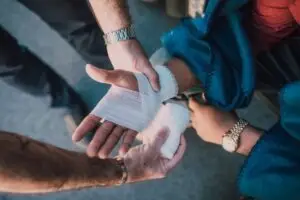 Dogs may be man’s best friends, but the bottom line is that they are still animals. Like all animals — humans included — dogs’ temperaments vary considerably, and even the friendliest canines can turn vicious with the flick of a proverbial switch. If you know this all too well, you may wonder, what can or should you do after a dog bites you? Though the answer depends largely on the severity of your wound, there are certain steps you should take to safeguard your health and preserve your legal rights.
Dogs may be man’s best friends, but the bottom line is that they are still animals. Like all animals — humans included — dogs’ temperaments vary considerably, and even the friendliest canines can turn vicious with the flick of a proverbial switch. If you know this all too well, you may wonder, what can or should you do after a dog bites you? Though the answer depends largely on the severity of your wound, there are certain steps you should take to safeguard your health and preserve your legal rights.
Dog Bite Statistics
As a dog bite victim, it may help you to know that you are not alone in your troubles. Per the Centers for Disease Control and Prevention, approximately 800,000 reportable dog bites occur each year. “Reportable” bites, according to the CDC, are those that necessitate medical attention. What is more alarming is the fact that as many as 334,000 dog bites are severe enough to warrant hospital-level care.
When you break down these numbers, you can fully appreciate the magnitude of the aggressive canine problem in the U.S. Every day, approximately 2,400 dog attacks occur. That means 100 attacks occur per hour and one every 36 seconds.
What is more alarming is the typical victim profile. More than 50% of all dog bite victims are children. Of the adults who sustain wounds, just 12% necessitate medical care. However, of the child victims, 26% require emergency room attention. When children do sustain bites, it is typically to the neck, face or head.
Like many people, you may assume that most dog bites happen outside of the home and between a strange dog and person. Sadly, this is not the case. The most likely place for a dog bite to occur is in the victim’s own home. The second most likely place for an attack is within a friend’s home. As many as 70% of all dog bite cases in the U.S. involve victims’ family dogs or dogs of friends or relatives.
What these statistics should tell you is that, regardless of how friendly or loving a dog may seem, it has the potential to cause harm. When one does, it is important that you know how to react appropriately.
Identify the Type of Wound
Though not necessarily the first thing you should do when a dog bites you, it is helpful to understand the various levels of dog bite wounds so that you can know how to respond appropriately. Medical professionals categorize dog bite wounds by severity and at the following five levels:
- Level 1: There is no wound, as the dog’s teeth did not touch the skin. The dog may, however, have torn clothing.
- Level 2: A level two wound is a surface wound and occurs when a dog’s teeth touch the skin but do not break the skin.
- Level 3: This type of wound consists of shallow puncture marks that are slightly beneath the skin.
- Level 4: The dog causes one to four punctures from a single bite, with at least one of the punctures being deep.
- Level 5: Level five wounds occur after a dog bites multiple times and causes one or several deep puncture wounds. Professionals classify level five events as “dog attacks.”
Once you identify the type of wound you sustain, take appropriate action immediately.
At-Home Treatment for Dog Bite Wounds
Regardless of the nature of the wound or wounds, one of the first things you should do following a dog bite is cleanse the afflicted area. Use fragrance-free soap (if you have it), water and a clean cloth to gently clean the area. If the wound is bleeding, use a clean cloth to apply gentle pressure to it for approximately five minutes. Once the bleeding stops, then cleanse the injury with soap and water. If the wound is beyond skin deep, douse it with water several times to flush the area of possible infection-causing bacteria.
If you sustained a level three through five injury, try to keep the affected area above the heart to prevent swelling and possible infection. Drape it loosely with a bandage to prevent contaminants from entering the wound.
If your bite is a level one, two or three, you can probably safely manage the treatment of it at home. Continue to wash the wound daily, and keep an eye out for signs of infection. Those include but are not limited to redness around the site, warmth, swelling, whitish-yellowish discharge and a foul odor. You may also develop a fever.
When To See a Doctor
Level four and five dog bite wounds necessitate immediate medical treatment. A professional can thoroughly clean the wound and properly bandage it so as to prevent further contamination. A doctor can also take adequate prevention measures, such as delivering a tetanus shot and/or rabies vaccines, and prescribe antibiotics to prevent or control infection.
Regardless of what category of dog bite you sustain, there are certain circumstances in which you should always seek medical attention. Those are as follows:
- You are bleeding profusely from one or several wounds
- Bleeding does not stop after 15 minutes of you applying gentle pressure
- The bite broke skin
- You are unsure of the dog’s vaccination history
- The dog is wild or a stray
- Your immune system is compromised or weak
You should also seek medical attention as soon as you notice signs of infection, even if the bite occurred hours or days before.
Always Request Vaccination Records
If you know or have contact with the dog’s owner, you should request the dog’s vaccination records immediately. Ask for either a copy or to borrow the originals, as you will want to take the records along with you to the doctor. Your doctor can use the information to determine the appropriate course of treatment for your injuries.
Reporting Requirements for Dog Bites
State laws vary as to whether you have a legal obligation to report a dog bite. Some states require all victims or dog owners to report incidents, regardless of their severity. Others, such as California, North Carolina and New York, require victims, owners or medical professionals to report bites that necessitate medical care. Despite reporting requirements, you should report a bite immediately to both animal control and the police.
Animal control can investigate the situation and ensure that the aggressive dog is up to date on its vaccines. It can also review the dog’s history to determine if the incident is part of a pattern of behavior or a one-time event.
The police, on the other hand, can manage the situation and ensure you receive the medical care you need and that the dog’s owner fulfills his or her post-bite obligations. The police can also file a report for the incident, which will come in handy should you need to file an insurance claim.
When To Contact a Dog Bite Attorney
A dog bite attorney is not necessary in every dog bite case. However, if your injury is more severe and necessitates extensive or ongoing medical care, results in lost wages and causes other damages in other areas of your life, you may consider filing a dog bite claim against the negligent owner. In this case, you would want to contact a dog bite lawyer right away. At the very least, a compassionate attorney can assess your situation and determine if you have a case. When you turn to a law office such as Jason Stone Injury Lawyers, you can have peace of mind that when you schedule a consultation, there is No Obligation, Just Information ®.
Not Trusting What You’re Being Told?
Better Phone Stone
800-577-5188
 START MY NO OBLIGATION CONSULTATION
START MY NO OBLIGATION CONSULTATION











